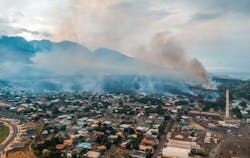In a market already defined by a severe shortage of available housing driving up sales prices and rental payments, climate change is adding to issues of affordability. In markets such as Maui, Hawaii, which recently experienced a devastating wildfire, residents now find themselves in a housing crisis exacerbated by a climate emergency, CNN reports.
Even before the fire, housing on the island was difficult to find and even harder to afford. Now, as Maui residents rebuild, many face an even longer road to affordable housing, and they aren’t alone.
Over 14.5 million homes in the US were affected by natural disasters in 2021, according to a report from Corelogic, a real estate data company, amounting to an estimated $57 billion in damage. That included about 4,000 homes impacted by wildfire, 560,000 homes impacted by severe weather like tornadoes and hail, more than a million homes impacted by hurricanes and over 12 million homes that were impacted by winter storms causing water damage and burst pipes.
These extreme weather events are increasing. By the beginning of August – before the fire in Maui – there had already been 15 confirmed weather or climate disasters that had losses over $1 billion each in the US this year, according to the NOAA National Centers for Environmental Information. Between 1980 and 2022 the average number of events of that magnitude each year was eight. The annual average over the past five years has risen to 18.
This is putting more people at greater risk, including 60 million homes in areas that could expect at least moderate losses, according to a report from the Joint Center for Housing Studies at Harvard University.
